The SANlight EVO series LED grow lights are very expensive, but the plants love them!
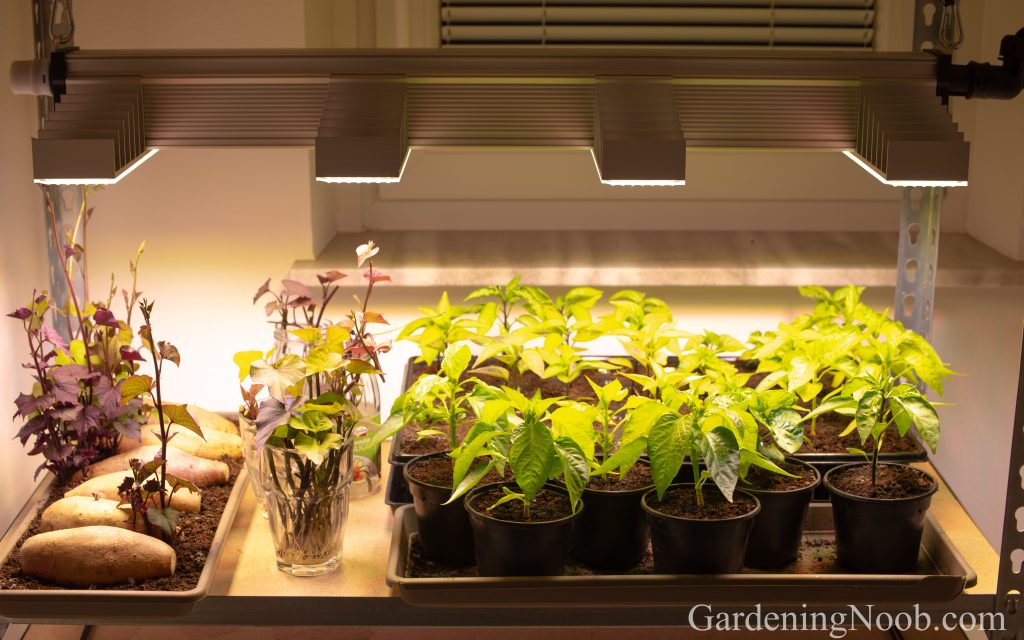
I have been using SANlight EVO grow lights since the beginning of year 2022 and I absolutely love them. I purchased them because I wanted to grow my own vegetable seedlings from seeds indoors. Now, after successfully raising thousands and thousands of healthy and strong vegetable plants with them – from bell peppers and tomatoes to sweet potato slips and eggplants – I can honestly say that they do wonders for the plants!
However, there is one serious drawback to them. It’s their cost. You see, the LED grow lights from SANlight EVO series are expensive. Their smallest model (EVO 3) is nearly 400 EUR ($430), and their largest model (EVO 6) is about 700 EUR ($760). This represents a substantial investment for an average vegetable seed starting hobbyist like myself…
The high price is justified, though, and is not a matter of manufacturer greed. It just reflects the superiority of the the product:
- They cover the entire light spectrum which means you can use them in all stages of plant growth, including flowering.
- They are build to last for years and years with minimal loss of light output.
- They use the latest LED technology and are constructed from high-quality materials and are thus very energy efficient.
Before I started growing vegetable seedlings indoors, I knew absolutely nothing about indoor LED grow lights. But I could tell right from the start that the plants thrive under them. I didn’t understand why – well not until recently, when I set out to write this SANlight EVO review and delve deeper into the product. Now, it all makes sense, and I’m glad I went with these lights over any others. Keep reading to find out more…
The Pros: Why I like the SANlight EVO grow lights
The first thing I would like to do in this review is point out all the things I like about SANlight EVO grow lights – the things that make it stand out from the competition:
Incredibly powerful, yet energy-efficient
These grow lights are incredibly powerful, yet very efficient when it comes to electricity consumption. In other words, they produce plenty of useful light for the plants, but do so without wasting energy in the form of excess heat or in the form of non-usable light.
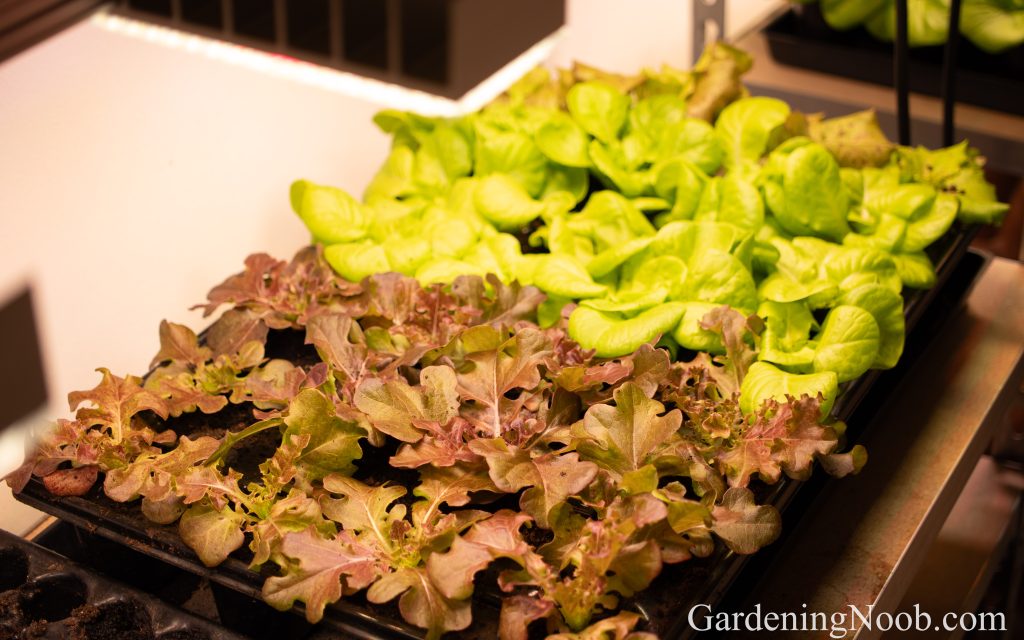
It’s no surprise then that their light performance metric (measured in μmol/J) is so high. They generate about three micromoles of Photosynthetically Active Radiation (PAR) for every Joule of electricity consumed and thus fall into the category of high-efficiency LEDs.
Here is what makes them so highly efficient at converting electricity into usable light:
- No overheating. The passive heat sinks dissipate excess heat away from the electronic components (and away from the plants too!) without requiring additional electricity.
- Minimal light output losses. The secondary 3D lenses direct the stray light from the LEDs back onto the plants. The end result is a very uniform (homogeneous) light distribution and the light output losses are reduced to just 4%.
- Adjustable light intensity. The magnetic or bluetooth dimmers let you adjust the intensity of the light according to your needs. I keep my lights dimmed to 40% for most of the time which cuts down on energy consumption significantly, but still gives vegetable seedlings – at least while they are still in the vegetative state of growth – enough light to grow.
It was essential for me to find grow lights that are powerful enough to take the plant from a seed to a well-established seedling. I definitely found that in SANlight. But what I have come to appreciate even more about this product is that it uses less energy than other less efficient models and brands to achieve the same (or possibly even better) results. This helps keep our electricity bill lower.
Suitable for all stages of plant lifecycle
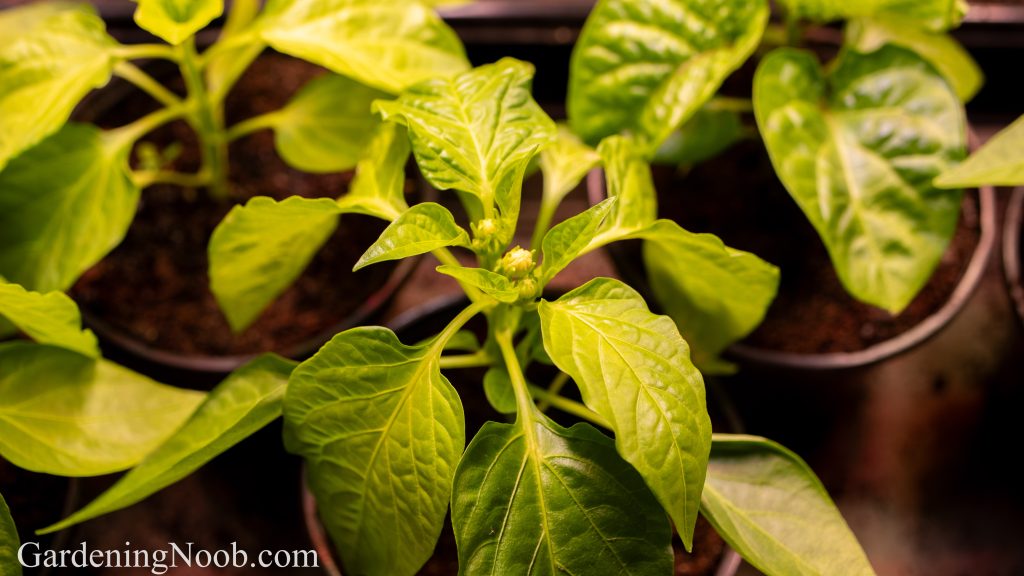
Another thing that stands out to me about SANlight is that you can use it in all stages of plant lifecycle – from the initial vegetative stage as well as to flowering and fruiting. The LEDs emit a broad spectrum of light (ranging from 400 nm to 780 nm), which is very similar to the visible spectrum of natural sunlight (380 nm to 750 nm). You can find all the cruical wavelengths for plant growth and development within this spectrum:
- Blue light (400 nm to 495 nm). It is essential for plants in the vegetative stage because it stimulates root development, chlorophyll production, leaf growth, gas exchange and absorption of nutrients.
- Red light (620 nm to 750 nm). It is essential for the flowering and fruit production.
- Green light, yellow light and orange light (495 nm to 620 nm). These lights are not as important as blue and red, but they still contribute to the overall growth, development and health of the plants by helping create a more balanced and diverse source of light.
- Near infrared light (750 nm to 780 nm). This is a non-visible segment of the light spectrum which regulates photomorphogenic processes such as stem elongation and leaf expansion. It can also warm the plants up without causing heat stress, as well as give signal to the plants that they are shaded, so they can search for more light by elongating their stems and growing more and longer leaves.
Since I have been mainly interested in vegetable seed starting, I could easily get away with grow lights that produce blue light only. However, there is evidence that suggests that plants can benefit from a broader spectrum of light as well – even if they are in the vegetative stage. It is also comforting to know that if I ever decide to grow fruit-bearing vegetables indoors, I won’t need to buy any extra lamps or bulbs for flowering and fruiting.
Built to last for a very long time
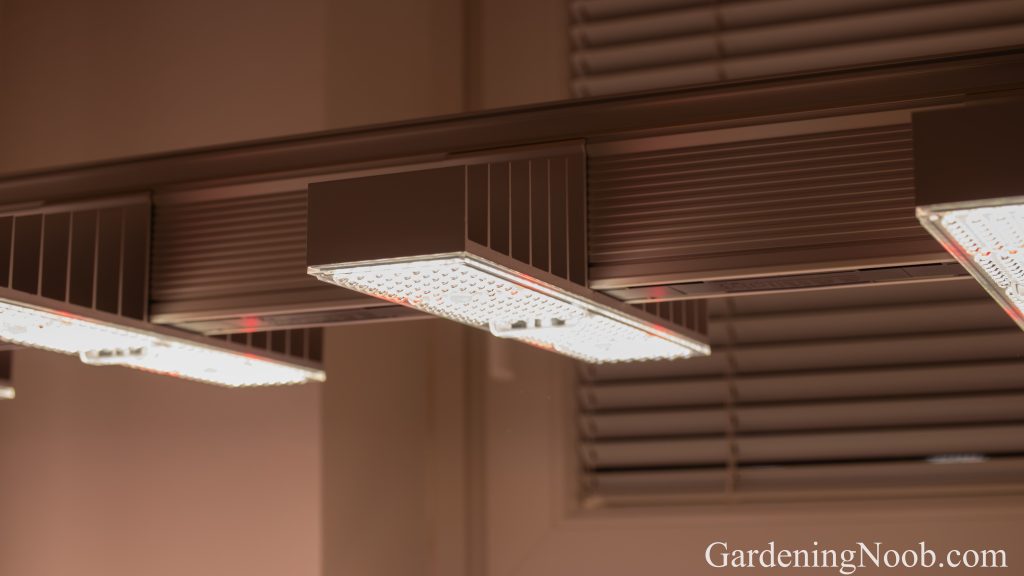
I researched all the aspects of the SANlight EVO series in detail. And I came to the conclusion that these LED grow lights were built to last a very long time. Here is why:
- The loss of light quality over the years is minimal. The lights have lumen maintenance measure of LM90: > 90,000 hours. It means that you could run them for 20 years, 12 hours a day, and they would still retain more than 90 % of their initial light output.
- The LEDs (light emitting diodes) come from reputable companies. The white LEDs integrated in the product are sourced from a south korean company named Seoul Semiconductor which is known for being the leader in efficiency, lifespan and color quality. And the red and far-red LEDs are produced by OSRAM which is another innovative company in the LED industry based in Germany.
- The reflectors are protected with high-quality coating. The reflectors inside the lights are coated with titanium oxide. It makes the LEDs more powerful without increasing energy consumption. What is more, the coating also protects the LEDs from long-term degradation. The titanium oxide is highly resistant to heat, as well as to to negative effects of UV light exposure, and thus adds a lot to the longevity and durability of the product.
- The design includes several passive-cooling heat sinks. The passive heat sinks are energy-efficient and prevent the lights from overheating. The LEDs can consequently run at optimal temperature and preserve their light output power. There is also less chance of malfunctions in other internal electronic components over time because of it.
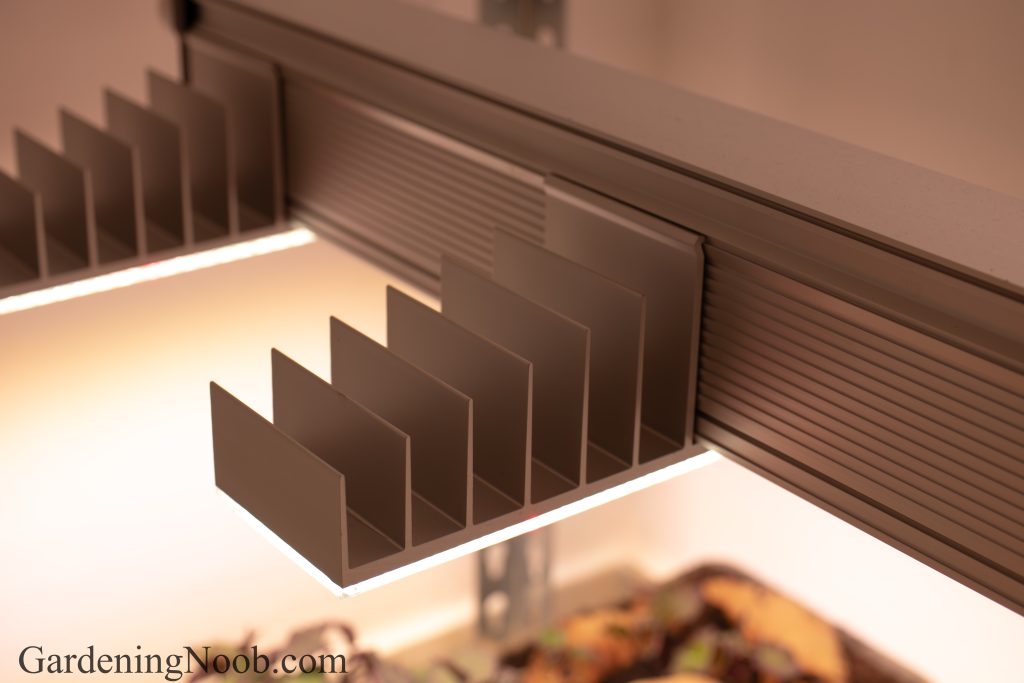
- They were built for harsh and humid growing environments. The grow lights (including the connectors) are rated IP65 for protection. This means that they are dust-tight and water-resistan and can withstand humidity levels of up to 99%. You can expose them to rain, spill water on them and clean them with a moist cloth without any worries. I keep my indoor vegetable seed starting setup in a fairly dry and dust-free room, but these lights are definitely suitable for use in greenhouses or hydroponic systems.
The team at SANlight clearly spared no expense on material quality. The reflectors are coated with titanium oxide. The heat sinks are made from aluminium. The 3D optics are bult from dust-resistant and moisture-protective PMMA. They have chosen top-notch suppliers for their LEDs. It all adds up. And the end result is a durable product that is easy to maintain, highly reliable, and, I believe, will serve me well for over a decade.
Other positive things that are worth mentioning
To this point, I have highlighted the key reasons why I appreciate SANlight EVO series grow lights. Yet, there are other features that I also like:
- Adjust the light intensity with a magnetic dimmer. The magnetic dimmer that attaches to the side of the lights allows you to control the intensity of the LEDs. With the use of the magnetic key, you can set four different brightness levels. I usually keep mine at 40%, but you can also set it to 60% (one green light on the dimmer turns on), to 80% (two green lights turn on) or to 100% (three green lights turn on).
- Have even more control over light intensity with a Bluetooth dimmer. Instead of the magnetic one, you can use Bluetooth dimmer and control brightness levels with the SANLIGHT mesh app (available on Google Play as well as in App Store). This way, you can set the brightness anywhere from 20% to 100% in 1% increments. The app allows you to connect up to 3200 lights to it, group them in different categories and then simultanously switch them on and off.
- Use the grow lights in pairs (or even groups of three) and make your setup even more effective. The hanging system has five hanging holes on each side which allows you to hang the lights under three different angles – 0 degrees, 11 degrees and 17 degrees. This means that you can combine two (or even three) units together into one cohesive setup by intercrossing their light beams. The light from each unit can thus penetrate deeper into the plant canopy and make the plants grow and develop even faster.
- Choose the model that best fits your needs (and budget). You can choose from four different SANlight EVO models available (EVO 3, EVO 4, EVO 5 and EVO 6) and each model is available in different variatians. The models and their variations differ in several aspects: (1) in the number of main LED beams, (2) in the distance between main LED beams, (3) in the overall length (but not in width or height), (4) in weight, (5) and in overall light output and consequently in energy consumption. The new 1.5 versions of these models produce a slightly higher PAR output per second but also consume a bit more electricity.
The model I own is the EVO 4-100. The first number (4) indicates that the model has four main beams. The second number (100) refers to the variation of the model. This particular variation is 81.8 cm (32.2 inches) long, with 23 cm (9.1 inches) between the centers of the beams. There is a shorter variation available too (EVO 4-80) with less distance between main beams (EVO 4-80), as well as a longer variation with more distance between the beams (EVO 4-120). The story is similar with other models, so you are bound to find one that will be just the right size.
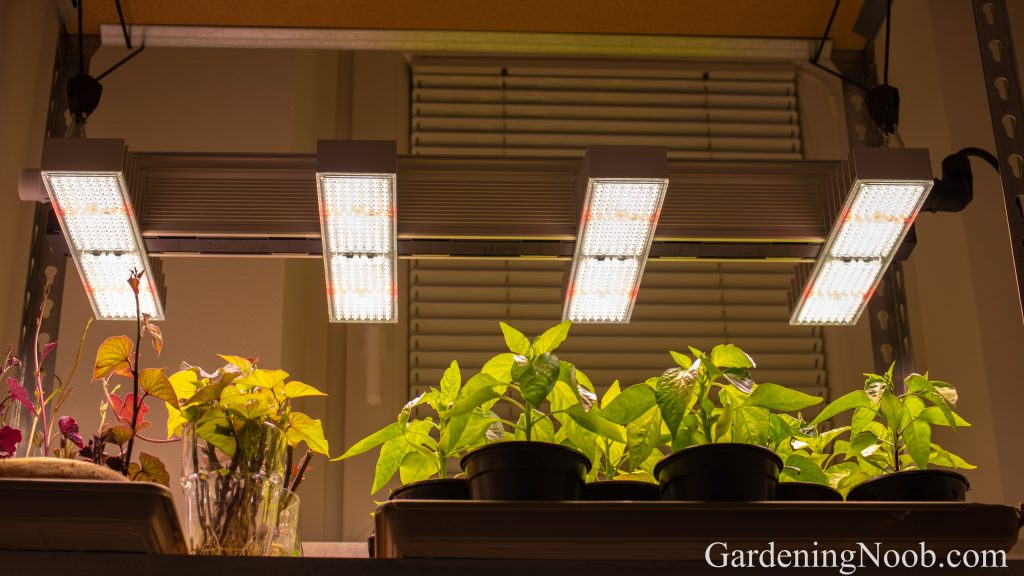
The Cons: What I don’t like about SANlight EVO grow lights
It is clear by now that I’m a big fan of SANlight EVO series. I wouldn’t swap these lights for anything else (at least not for now), but there are certain things about them that I don’t like:
- The hanging equipment is difficult to use. Despite the clever design of their multi-hole hanging system, the hanging equipment itself is nothing special. In fact, it is very difficult to adjust the height of the lights so that both ends are aligned. It took me several back-and-forth tries.
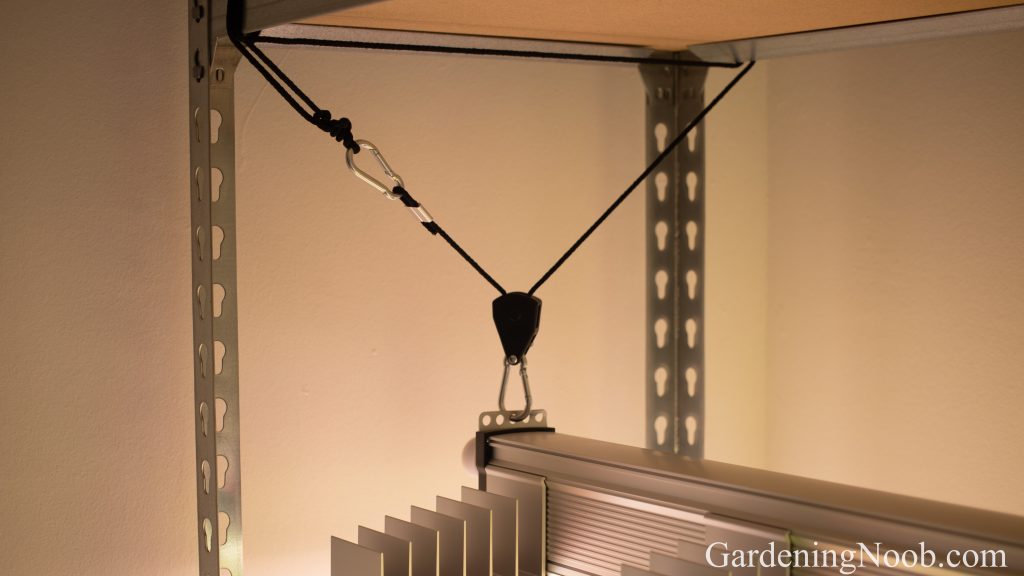
- There is no built-in on/off switch. To turn the LEDs on, you need to plug the power cable into the extension block. And to turn them off, you need to unplug it. This can be awkward and time-consuming when you are doing it every day. As a workaround, I have used an extension block that has the on/off switch built in, but you could also install a Bluetooth dimmer instead and then do it via the SANlight mesh app.
- It is challenging to remove the protective caps from the electricity and dimmer sockets. The electricity and dimmer sockets on the lights come equipped with protective caps which are great for protecting the lights against moisture and dust during storage or transport. However, I found them very difficult to remove. It took a lot of physical strength, and I was worried about potentially breaking something. Fortunately, I only had to do it twice for each light.
- They are expensive.The lights are clearly made for professional use. They use advanced technology and were built from high-quality materials. And these don’t come cheap. I am okay with the high price tag because I use SANlight almost all year. But if you plan to use the grow lights just for a few months in a year – in spring, for instance, to raise a handful tomato or bell pepper seedlings from seeds – then you may want to consider a less expensive option.
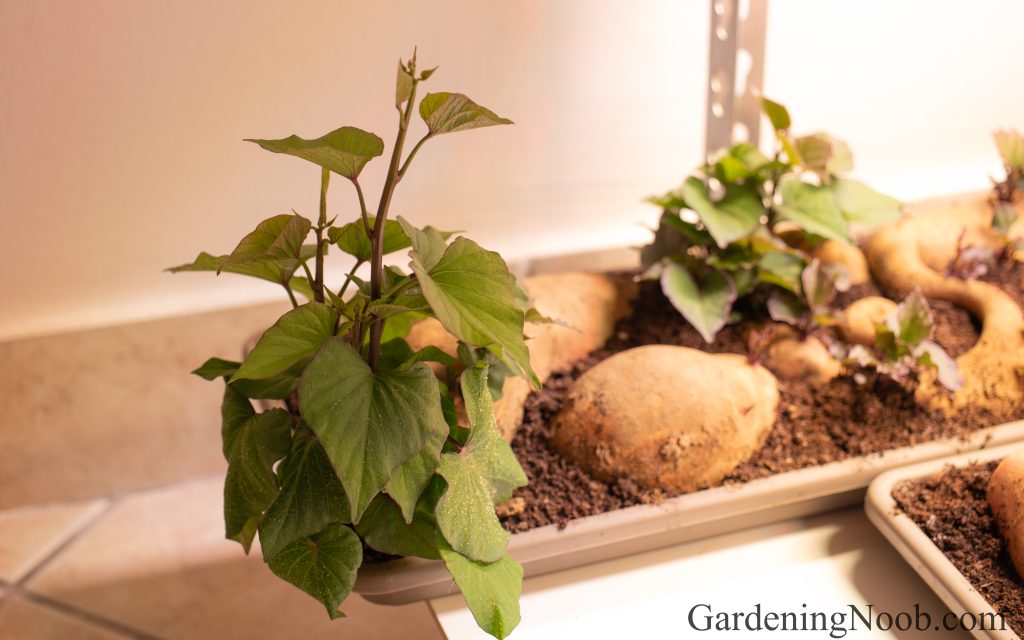
What is usually included (and what is not included) when you buy SANlight EVO grow lights
If you’re considering the SANlight EVO series grow lights, you may want to know what is included in the standard package, and what you will need to buy separately. Here is what you get with the most basic purchase:
- The actual LED grow lights. You can choose from various lengths. The shortest model (EVO-3) has three main beams and is available in three different lengths: 46.8 cm (18.4 inches), 64.3 cm (25.3 inches) and 81.8 cm (32.2 inches). The longest model (EVO-6) has six main beams and is available in two different lenghts: 101.8 cm (40.1 inches) and 131.8 cm (51.9 inches).
- Two protective caps for each unit. These are mounted on the dimmer and electricity sockets – one on each end of the lights. You will need to remove both in order to connect the dimmer and the power cable to the lights. But don’t throw them away. They might be useful in the future if you ever decide to store the lights for a longer period of time.
There are also additional items that you may also want to buy. Some are necessary to operate the lights, like the power cable and hanging set, while others improve functionality, such as the Bluetooth dimmer or the adapter cable for digital environmental controller. Here is the complete list:
- The power cables (cords). These connect the lights to electricity. Their L-shape design makes them suitable for tight spaces and grow boxes. They are available for various electricity plug standards, including the European union (EU), United States of America (USA), United Kingdom (UK) and Switzerland (CH). Each cable is 2.1 meters (about 6.9 feet) long.
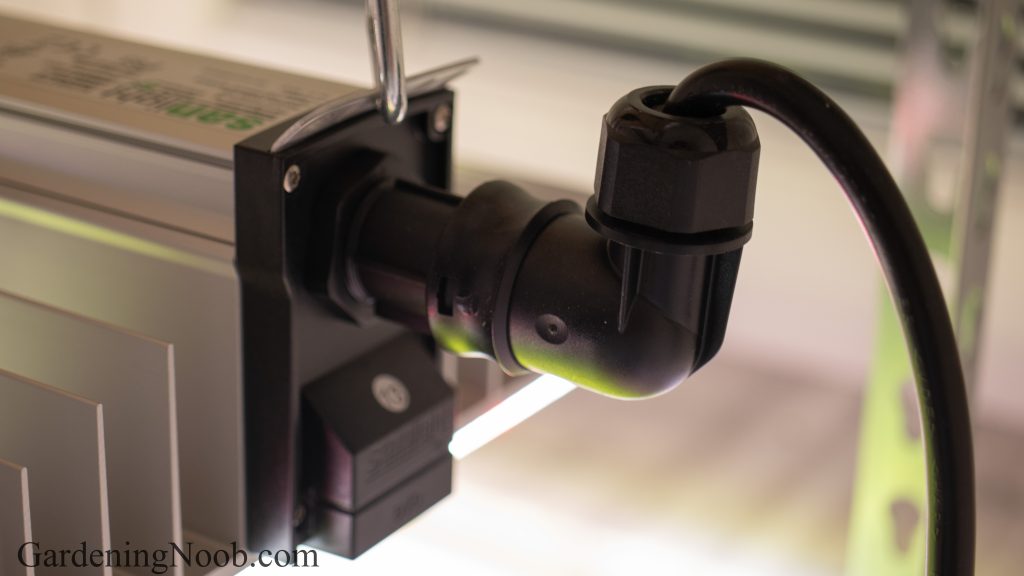
- The dimmers. Unless you intend to run your lights at full brightness all the time, you will need one dimmer (either magnetic or Bluetooth) for each grow lights unit. I use the magnetic one, but if you plan to have a setup with units, then choosing the bluetooth dimmer might be a more practical choice.
- The hanging sets. These are essential, because you can’t suspend the lights over the plants without them. I have mentioned why I don’t like these kind of rope ratchets, but if you don’t have a better alternative, they will still serve their purpose.
- Extension cables (daisy chain connectors). You can use these to extend the main power cables, as well as to to connect multiple lights together (via H-distribution blocks) and power them from a single electricity plug. Each extension cable is 1 meter (about 3.3 feet) long.
- H-distribution blocks. These enable you to connect (daisy chain) multiple lights together into one larger setup and power them from a single electricity plug. They essentially help keep your growing environment more organized and less cluttered with cables.
- Inrush current limiters. These help prevent unnecessary power shutdowns by smoothing out spikes in current when multiple units are turned on simultanously. I have only two grow lights, so I don’t need the limiters, but it you plan to run four or more from the same electricity plug, you might want to consider getting one.
- The adapter cables for digital environmental controllers. These connect the grow lights to the digital environmental controllers. I don’t use the controllers, but they can be incredibly useful in larger, professional setups where precise monitoring and control of growing conditions is much more important. The adapter cables are available for the following controllers: Growbase, Growbase Pro and Trolmaster.
The list of things that you need to purchase separately may seem long, but fortunately, there are also sets available. For example, I purchased a set that included one SANlight EVO 4-100 grow light, along with a power cable, a magnetic dimmer, and a hanging set. This gave me everything I needed to start growing plants. Purchasing the items as a set was also slightly cheaper (not much though) than purchasing them individually.
Are you ready to start growing plants indoors with SANlight EVO?

I wrote quite a lengthy review, I know, but I did it because I wanted to include everything in it that I think is important about these grow lights. If you want a shorter version, then all I can say is that these LED grow lights are absolutely worth the investment – despite their high price. Here is why:
- The plants thrive under them.
- They are built to last years if not even decades.
- They are energy efficient.
- You can use them separately as a single units, as well as in large-scale setups and operations.
- They are available in various lengths.
Click here to buy SANlight EVO grow lights through my affiliate link
So, if you are interested in growing plants indoors with these lights, please consider purchasing them through my affiliate link above. By using this link, I earn a commission from your purchase, which helps support the further development of this website. You will be directed to a reputable online store where I purchased mine.
